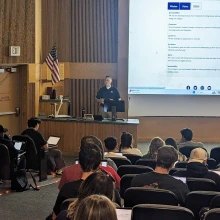Education
Leadership and Ethics Courses
The Center for Leadership Ethics is dedicated to cultivating ethical awareness and principled decision-making through an engaging and forward-thinking curriculum. Our comprehensive suite of undergraduate and graduate courses empowers students to confront complex ethical challenges in business, leadership, and society.
Through interactive coursework, real-world case studies, and exposure to current ethical dilemmas, students strengthen their ability to reason critically, lead responsibly, and create positive impact within their organizations and communities.
Enriching the classroom experience, the Center regularly hosts distinguished guest speakers who share their leadership journeys and practical perspectives on ethics in action. Recent speakers include Steve Holmes, Pima County Deputy Administrator; Irene Coppola, CEO/Director of the Better Business Bureau Serving Southern Arizona; Pat Risner, President of South32; and Sam Credio, Director of Transportation for the City of Tucson.
For course scheduling and additional information, view the University of Arizona course catalog.
|
This course focuses on exploring morality, ethics and decision-making by looking at contemporary practices in business. Students discover theoretical and practical ways to approach moral and ethical dilemmas in organizational life and improve their skills in moral reasoning and ethical decision-making. Units: 3 |
An interdisciplinary analysis of how fundamentals of economics, finance, accounting, marketing, management and information technology each raise ethical and legal considerations in the business environment.
Units: 3
|
This course explores how law and stakeholder interests impact corporate social responsibility, giving participants a solid understanding of the role of ethics in management and experience managing tradeoffs in ethical decision-making. Units: 3 |
This course explores how ethics, law and the regulatory environment impact corporate activities, giving participants a solid understanding of the role of each of these in organizational decision-making.
Units: 3





